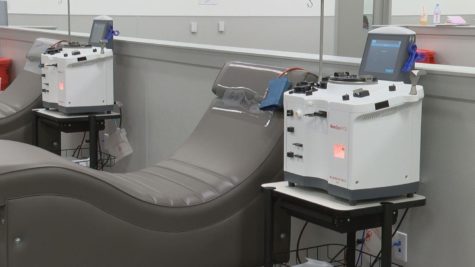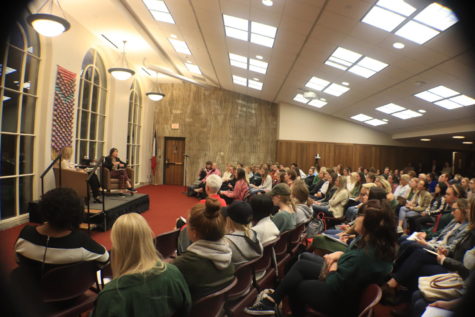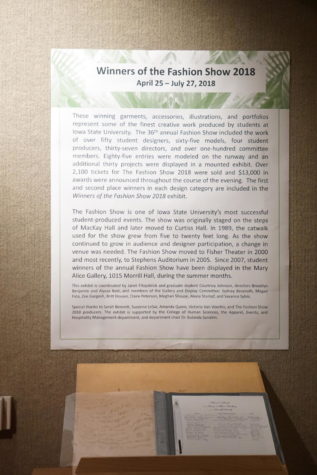10 ways to use a medicine ball
September 20, 2014
The craze of leading a healthy lifestyle by eating right and working out is on the rise, and more and more people are choosing to train either with a personal trainer or by themselves. ISU students aren’t any different. Personal training is increasing in popularity on campus, especially in recent years.
According to Nora Hudson, assistant director of fitness and wellness for Iowa State’s Recreation Services, Iowa State has been offering personal training for its students for eight to ten years.
“I have about 35 trainers, and each trainer has somewhere between two to three clients … So, they’re very engaged. That’s a good-sized program,” Hudson said. “We’re [at] about a 15-20 percent increase [since the program started]. We’re growing every semester. We’re gaining.”
Hudson continued to explain the benefits of personal training.
“I think that it can be a useful tool. Part of our philosophy isn’t to try to create a ‘Velcro’ relationship with the trainer. It’s about educating [students] to know how to organize their workouts and understand how to be successful on their own.”
Some students partake in personal training as little as once a week just so that they can have someone to keep them accountable and going.
“The students a lot of times don’t have the time to have bond commitments with personal training, but it helps. Some kind of get their focus on how to work out properly and set some realistic goals and … build the confidence that they can do it on their own.”
Even though having a personal trainer helps you build yourself up to the point where you can train yourself, some students may be concerned about how to fit the training into their busy schedules. Rec services offers 30- and 60-minute sessions as well as group fitness classes that alternate times throughout the day.
“There are just so many ways that we can get students involved in fitness,” Hudson said.
Even though Rec services tries to make it so that all students can partake in some sort of fitness activity during their week, there are some students who still have time constraints. And for those students there is one simple piece of equipment that is very versatile on its own — the medicine ball.
“I do [use medicine balls] with circuit training. I tend to use them a lot. [They’re useful for] anywhere between shoulders and abs to chest,” said Brad Freeman, senior in kinesiology and health and personal trainer at State Gym. “You can literally use the medicine ball for any part that you want.”
So, if you don’t have the time for a personal trainer or a group fitness class, here’s a list of exercises you can do by yourself with a medicine ball. However, be careful with the different movements; some should not be attempted by novices with beginner coordination and weak cores.
Core:
-
Side-to-side slam:
Sit on the floor with your knees bent and hold the medicine ball in the middle of your chest. Raise your knees to a 90 degree angle, keeping them parallel to the ground. Twist your torso to the right and tap the ball just outside of your right hip, keeping your feet elevated off the ground. Twist your torso to the left to do the same. This is one rep. Continue for 20 reps.
-
V-up:
Lie flat on your back with your arms and legs extended, so that your body creates a straight line. Holding the medicine ball in your hands, engage your core and bring your arms and legs up simultaneously into a V position. Place the ball between your feet and slowly lower your feet and arms back to the floor. Continue for 10 reps, exchanging the ball between your feet and hands during each rep.
-
Overhead slam:
Stand with your feet shoulder-width apart and knees slightly bent. Lift the medicine ball off the ground to an overhead position, holding it with both hands. Keep your back straight as you bend at the hips to “slam” the ball down. Don’t actually slam the ball because control is key. Continue for 12 to 15 reps.
Shoulders and arms:
-
Figure eight:
Stand with your feet shoulder-width apart, holding the medicine ball with both hands to one side of your head. Slowly move the ball in a figure eight. Do that for eight reps starting off going one direction. Then reverse the direction for another eight reps.
-
Tricep extension:
Stand with your feet shoulder-width apart. Engage your core. Hold the medicine ball above your head with your arms fully extended. Keep them close to the sides of your head. Slowly bend your elbows to lower the ball behind your head until your elbows are bent at a 45 degree angle. To straighten your arm, squeeze your triceps while carefully raising the ball back to the starting position. Do this for 12 to 15 reps.
-
Shoulder press:
Start with your feet shoulder-width apart. Hold the medicine ball in front of your chest with both hands and press the ball above your head. Make sure that your arms are fully extended. Lower to starting position. For more of a challenge, increase weight. Do this for 12 to 15 reps.
Legs and glutes:
-
Single-leg squat:
Hold the medicine ball in front of your stomach with both hands. Stand with your feet shoulder-width apart, knees bent slightly. Lift your right foot off the ground and extend it out in front of you slowly while squatting down on your left leg, keeping the right leg from touching the ground. Stand back up to starting position. Do this for 10 to 12 reps.
-
Romanian dead lift:
Stand on your right leg, slightly bent at the knee. While pushing the medicine ball from away from your stomach, lean forward at the hips and bringing your left leg straight back. Your body should be in a straight line that’s perpendicular to your right leg. Return your extended left leg to the floor while bringing the medicine ball back to your stomach. Repeat for 10 to 12 reps for each leg.
Full body:
-
Lunge with a twist:
Standing with your feet hip-width apart and holding the medicine ball a few inches in front of your chest, lunge forward with your right leg first. Make sure that your right knee doesn’t extend over your toes and that your right thigh is parallel to the floor. Extend your arms straight out in front of you with the medicine ball and twist your torso to the right. Return to the standing position by moving the medicine ball to in front of your chest first and then stepping back to the starting position. Repeat for 10 to 12 reps with each leg.
-
Full body stand-up:
Start by lying down on the ground with your knees bent, feet flat on the floor and arms extended above your head, holding the medicine ball. Pull your knees into your chest and use the medicine ball and your core strength to propel yourself forward into a squatting and then standing position. Once standing, lower yourself back into a squat and then lie back down. Do a total of 10 to 12 reps.
















